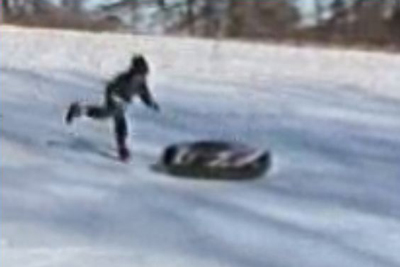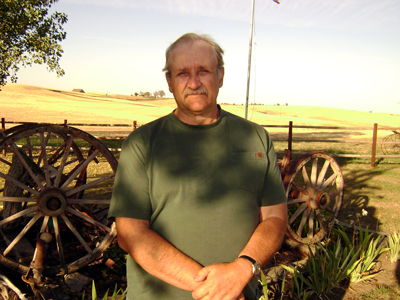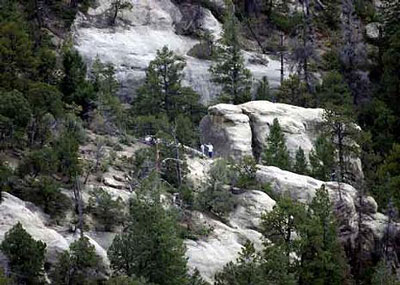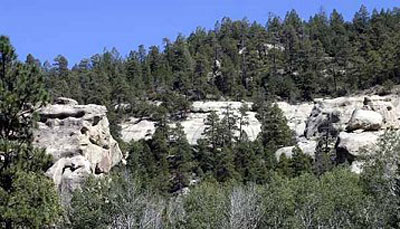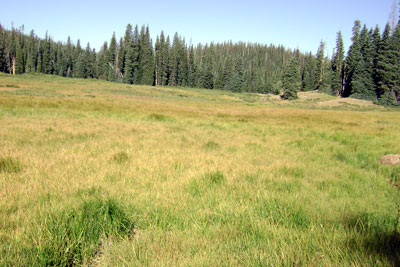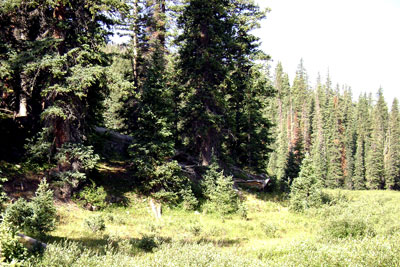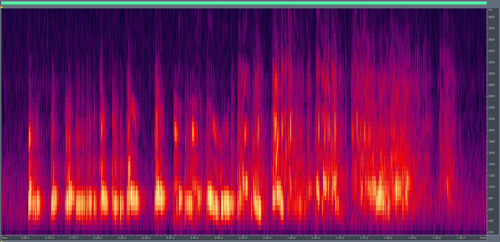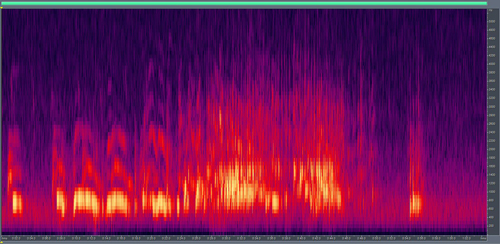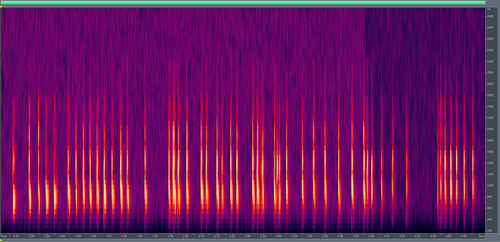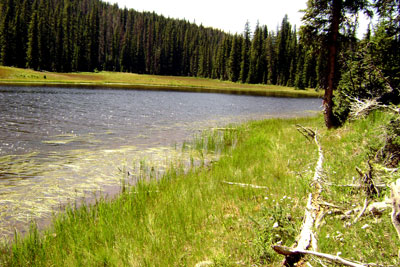Acoustic Attraction – Pt. 3
On the 23rd of May 2005 I was blessed to hear a full blown roar from about 200 yards. I was preparing to head to the creek with my dog in the evening. When I approached the fence which is about 125 feet from our house something near the creek let out a long, loud roar. It sounded like the animal had a very large chest and was in total control of how much volume was produced.
It made me realize that animals only vocalize a certain loudness that is of sufficient volume for the desired effect. To scare a human away from an area they might scream or roar loudly to accomplish their goal of running the humans off. But if they only want to communicate over a short distance why use a loud sound. The louder a squatch is, the more chance of being noticed by humans.
My point being that if I am going out into the night to attract a squatch why not use sounds of a lower volume, say something that can be heard from 100 to 200 yards away and not wake up the whole neighborhood. It certainly is more natural to play back a sound that is softer, then I can move several hundreds yards and do it again. It is more esthetic and it also keeps the local farmers from questioning me about my motives while they are carrying a loaded shotgun.
Birders have started using their iPods in the field to attract birds close enough to identify them. Since iPods do not have external speakers they must use external speakers.
Once such device is the iMaingo2. It weighs about 9 ounces and measures only 6 x 4 x 2, so it is highly portable and convenient to carry and use. The iPod is placed inside the unit and is usable through the clear plastic window.
Recently I tried the unit out while in Colorado. Please see –Rainbow Trout & Sound Blasting. I knew that there was a coyote den about 150 yards from our campsite, so I set my alarm for 3 a.m. I played a recorded lone coyote howl and waited.
To hear the response click here: Coyote chorus
So the unit has been shown to work at close to 200 yards, at least on coyotes.
Acoustic Attraction – Pt. 2
For sound amplification equipment I will review four general areas of equipment getting larger and more expensive. I am not stating that any one category is more effective as I don’t think that louder is better.
For this post we will start out with the lowly cell phone. It may sound silly but several years ago I put the Illinois Howl on my cell phone as the ring tone. It is a great conversation starter in public and almost always gets a comment from strangers when I get an incoming call .
At the end of Jun 2006 I told my wife I was going to go down near the creek where we lived and play-back my cell phone ring-tone of the Illinois Howl. She laughed and said don’t be silly, nothing can hear that ring. My response was that I bet I can hear that ring-tone from at least 50 feet and a squatch could hear it from at least 200 feet. So I went down into the pasture and stood next to the only tree growing along the fence row. I played two or three ringtones with the phone and went back to the house.
The next day I was down at the creek and as my son and I were walking back up through the pasture along the fence row my son said “Dad, look at that tree.” My response was well let’s go get the camera and let your mother look at it too. When I later asked my wife what she thought she said “I know what caused that but I don’t want to hear about for the next three months!”
Here is my blogpost from the 6th of August 2006.
I don’t like evaluating tree breaks or twists. I don’t recognize them as being bigfoot related. There are just too many other things they could be attributed to: storms, winds, old age. I don’t say that Uncle Harry didn’t do it as some type of territorial marker, I am just saying it is “not my thing.”
On the 1st of July 2006 this twelve foot tall four inch diameter maple tree was snapped in two along the path in the pasture just up the hill feet from my feeding station. There had not been any other damage on my property or my neighbors property. There was a path of knocked down tall grass from the hay field to the east directly to the tree.
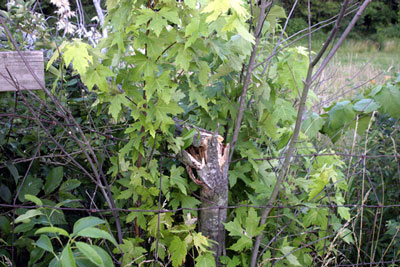
Acoustic Attraction – Pt. 1
Recently I made a comment about how I disliked the term “sound blasting”.
Reader Scott M submitted the following comment :
All methods fall under the concept of Acoustic Attraction…by wood-knocking…by mechanical call…by vocal immitation…by electronic amplification. I’ll settle on “Amplified Acoustic Attraction.†I like “Sound Braodcasting†too.  Keep up the good work.
I really like the term Acoustic Attraction because it takes out the negative image of giant speakers blasting out 120 dB of suspected sasquatch sounds. On the negative side, will readers even know what we are talking about by using a different term.
John Frietas, of  Northern California and BlueNorth.com is generally acknowledged as the “father” of sound blasting techniques.
As time has rolled along techniques have evolved and equipment has been refined.
The field of Acoustic Attraction is huge in the fact that almost any human activity may attract the attention of sasquatches. There are reports (both published and unpublished) of sasquatch activity being associated with the following list:
– Human activity that is normal in the course of daily life.
1. Children playing. Click here for a winter video of my own boys taken years ago.
2. Human babies crying.
3. Vehicles stopping along the woods (day or night).
4. Car doors slamming.
5. Common camping sounds, splitting of wood, campfires.
6. Hikers walking through the woods.
7. Fishing
8. Hunting
9. Berry picking
10. Mushroom hunting
11. Late night parking
and then you can add to the above list more outward human activity.
12. Singing or playing of musical instruments i.e. harmonicas, guitars, Jew’s harps, didgeridoo.
13. Human calls or vocalizations without using electronic amplification.
14. Wood knocks
15. Rock clacking
16. Calls and vocalizations broadcast using sound amplification equipment.
Camas Prairie, Idaho
Recently I spent the night with a lifelong friend in Northern Idaho. John Webb had known about my interest in sasquatch research and invited to his home where we could do some sound blasting and reminisce about “old times”.
I was born and raised in Northern Idaho. Idaho is a state of mountains, lakes and streams. But in the northern part of the state it also is an area that has lots of grain farming. As a child I had seen bobcat, cougar and coyotes. In recent years the elk have moved in as well as wolves.   Although the farming area has only a small amount of timber area it has very large canyons with large stands of pine that lead up into the rolling hills of the grain fields. As a kid I had hunted these canyons but we were always leery of the rattlesnakes. The summer of 1948 my dad killed thirty-five rattlers around our home.
Over the years there have been sasquatch sightings within about twenty miles and last year my wife found several (human looking) footprints three miles from my friend’s home.   Please see:  Small Footprints in Remote Areas.
John Webb standing in front of one of his old farm wagons with the grain fields of the Camas Prairie in the background.
I arrived at John’s farm in the early afternoon. John drove me around the edges of the canyons and we scouted out some good places to sound blast. You could easily see several miles across these deep narrow canyons. There are no permanent roads in these canyons with only the very rare hunter or local farmer out for a hike. And although arid looking this time of year we could get see flowing streams in the canyon bottoms. As a special treat John asked me if I would like to go through the home where I lived during most of the 1950’s. I had not been in the house since 1957. Memories came flowing back to me of my early childhood.
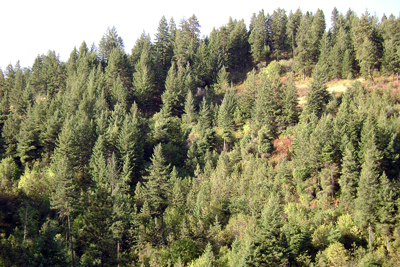
A younger stand of pine tree in one of the many canyons that disect the farm country.
We set out two recorders, one on the edge of each of two large canyons near John’s farm.  John has two grandsons, Kurt and Trent who accompanied us as we sound blasted. I was in hopes that we would get some return calls as I am sure these young men would have been very excited to hear something aswer us . At 4 a.m. John and I again drove to the two recorder sites and repeated the sound blasting.
The evening was very quiet. Crickets were active. We heard several groups of coyotes but they were at such a distance that their sounds are buried in the white noise of the recording. Other than the crickets and a few coyotes I did record a Great Horned Owl.
A big thank you to John and all of his family who accepted me into their home, listened to my bigfoot storys and showed me around the country that I loved as a child. And as a special note, John’s wife Carol fixed a wonderful breakfast that included huckleberry pancakes. For folks who have never tasted these wonderful berries of the Northwest there are a real delight.
To listen to a short interview with John and his grandson’s while we are out soundblasting – please click here:Â Â Camas Prairie
The Elk Hunt Interrupted
During an expedition in the northern part of New Mexico myself, my son, Stan Courtney
and M. took off from base camp to go find a footprint someone had discovered the
previous day. The footprint was supposed to be under a ledge in the limestone dust
where it was protected from the on and off rain we had on this trip. The footprint was
up one of the five “fingers†or valleys the host told us not to go up. He never
ventured up these “fingers†because it was his belief that the “big people†lived up
there and he did not want to intrude on their territory.
It was a strenuous hike though rain and a constant climb in elevation. We decided to
rest on a rock outcropping which jetted out towards to downward slope of the valley
we just hiked up. After a few minutes M. thought he saw something to our left but
after a brief investigation it was determined we could see the entire “bowl†to our left
and nothing could be down there without seeing it. We decided to remain on the rock
outcropping and rest some more. To our left was the way we hiked up the valley and
from our current position we could only look into the tree tops.
After a short while we started to hear wood knocks towards the bottom of the valley
we just ascended. After a few sets of wood knocks we determined there were
actually two sources of the knocks. The wood knocks continued up the valley and
alternated from one side of the valley to the other. I had a video camera recording
the whole time but the piece of equipment was not sensitive enough to catch the
wood knocks. When the knocks reached about half way up an elk bugled which the
video recorder caught.
During this constant and progressing knocking M. and I could hear something directly
below our position on the rock outcropping. There was not any distinct sound it made,
it just sounded like there was something moving around below.
After the two sets of wood knocks made it up the valley about ¾ of the way up, one
of the two-way radios we were carrying sounded with another group’s communication.
This noise abruptly stopped the wood knocking. We continued to listen and record but
nothing happened for a few minutes. Then, to our left and up valley from our location
we all heard clearly the vocalization “hay-ya†“hay-yaâ€. I was taken aback by this
vocalization because nobody else from our group was above our location and the
“accent†sounded Native American. Our host had told everyone that Native Americans
never ventured up this valley yet this sounded like one. After hearing these
vocalizations we waiting awhile but nothing else happened. We decided to leave and
head back down to base camp but wanted to stop by the location below our spot on
the rock outcropping to see if anything could be found.
When we arrived at the bottom of the rock out cropping we found a small stick with
sand on the end of it and a hole in the pine needles and limestone sand on the forest
floor that appeared to have been made by the stick. This hole had to have been
recently made due to the amount of rain we were receiving.
The video camera recorded the elk bugle, the vocalizations and I video recorded the
stick and hole in the soil as it was found.
Upon returning to base camp we explained to our host our encounter up the valley
and told him we heard “hay-ya†twice. He said that meant “Where are you?†in
Apache. Our conclusion to the events we witnessed is as follows:
Two Bigfoot were hunting elk and pushing it up the valley to trap it at the top as our
host had mentioned to us before our trip up the valley.
The juvenile Bigfoot was waiting below our location on the rock outcropping while the
others hunted. Probably bored, it starting playing with the stick in the soil.
Our two-way radio disrupted their hunt.
One of the Bigfoot called out for the juvenile once their hunt was compromised.
—————————————
From Stan –
For the elk sound click here: Elk
For the  “hay-yaâ€Â sound click here: “hay-yaâ€
Colorado Howl – Pt. 3
On Thursday, the 13th of August 1009, I drove to Colorado to attend a group outing.
My friends had obtained some interesting recordings in mid July 2009 (see
Colorado Howl – Pt. 1) and had encouraged me to check out the area. I then spent the
night of the 4th of August, 2009 (see Colorado Howl – Pt. 2) on location and was
fortunate enough to also record some vocalizations.
My plan was to spend four nights on location with five other researcher friends. Present
on this outing were:
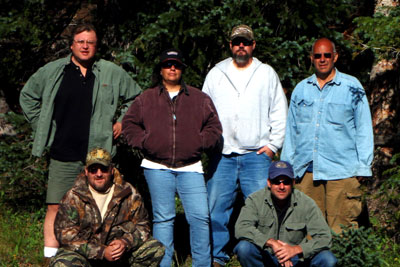
Photo Courtesy of Mark Taylor
front row – Mark Taylor and Todd Perteet
back row – David Petti, Carla Letendre, David Letendre and myself.
I arrived at sundown. Todd had the campfire roaring when I pulled in and we spent
the rest of evening in camp.
Night of 13th Aug – 14th Aug
There was a light rain. I left out my Marantz PMD 670 recorder (modified by Oade
Brothers Audio) and Todd was also recording with his Olympus DS50.
Nothing of note was recorded the first evening.
Part of the meadow.
Friday, the 14th – was spent around camp looking for good locations to leave out my
three recorders. Although it is impossible to know exactly where an animal is going
to position itself to vocalize the lay of the land can be a guide. Hopefully by using three
recorders I could determine at least an approximate area of where to drop off my
recorders and improve my chances of getting that elusive great recording. The rest of
researchers arrived during the late afternoon.
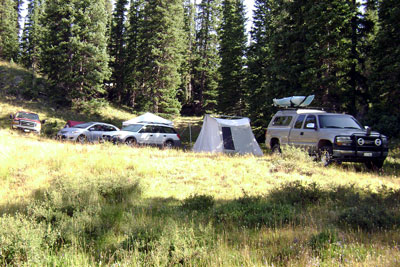
Basecamp.
At 10:30 in the morning we heard what sounded like howls coming from
approximately 300 yards due west of camp. The first series was about five howls and
the second set were about three howls. It is possible they could have been coyote but
they were to far away to determine. No recorders were running at the time and I doubt
very much that the recordings would have been of any value because of the distance
involved.
I placed out the following recorders.
The Sound Devices 722 recorder was placed in a small clump of trees on the east side of
the meadow. I wanted it to be at least far enough away from the campsite to not pick
up so much of the campfire noise and conversation. This was appoximately fifty yards
from camp.
Small clump of trees where the Sound Devices 722 recorder was located.
The Marantz 670 recorder was placed on top of a rocky knoll approximately 250 yards
southwest of camp. It was hoped that from this vantage point that sound could be
recorded from all directions. The Samson H-2 was kept at camp. The other researchers
also had their recorders placed either in or near the camp. In total seven recorders were
used.
Night of 14th Aug – 15th Aug
12:30 a.m.- We heard what sounded like a large tree falling about 100 yards due west
of camp. It was perfectly calm at the time. There was absolutely no wind. Almost
perfect recording conditions. It was quite unnerving to listen to what appeared to be a
very large tree falling in the night.
Click here to listen to sound clip:  Tree Falling  3
Waveform View
Spectral View
02:12 a.m – The Colorado Howler started calling from an area about 200 yards due west of camp. A total of nine calls were heard. most of which exhibit a very unusual “hitch”, “catch” or anomaly which has not been demonstrated in any known coyote sound clips.
Click here to listen to sound clip: Â Colorado Howl 3
Waveform View
Spectral View
03:18 a.m. – The coyotes start up their serenade. Nothing suspicisious is noted among
the many vocalizations.
http://www.stancourtney.com/sounds/2009.08.15_03_722.mp3
http://www.stancourtney.com/sounds/2009.08.15_03_670.mp3
http://www.stancourtney.com/sounds/2009.08.15_03_H-2.mp3
http://www.stancourtney.com/sounds/2009.08.15_03_DS50.mp3
Waveform View
Spectral View
03:26 a.m – The coyotes again start up, but this time at the 36 sec mark you can now
hear the Colorado Howler adding in his calls.
Click here to listen to sound clip: Â Colorado Howl 4
Waveform View
Spectral View
08:15 a.m – I was reluctant to pick my recorders up too early in the morning because
sounds have been collected at this site long after sunrise. I thought that after 8 in the
morning would be fine, as I was concerned to get all my batteries recharged for the next
nights recording session.
As I was picking my way through the woods and walking only 10 feet from my recorder
again the Colorado Howler started up again 200 yards due west of camp. It really
surprised me at first. I thought “how is my recorder playing back sounds”? Then I
realized where the sounds were coming from. I quickly tried to position myself to get
either a visual on the Colorado Howler or the coyotes.
Everything was lined up in a straight line. My recorder was due west of me about ten
feet, the coyotes were about 100 yards due west of me in the woods on the western
side of the meadow and then the Colorado Howler was about another 100 yards west
of the coyotes.
So what we have on this recording is the Colorado Howler starting up and the coyotes
joining up from a different position.
Click here to listen to sound clip: Â Colorado Howl 5
Waveform View
Spectral View
Saturday, the 15th was spent in scouting out the local area.
I was unhappy with the recording from the top of a rocky knoll using the Marantz so I
moved it to about 200 yards due west of camp in a wooded draw. This is where the
Colorado Howler appeared to be calling from. Since we had others recording in camp I
moved my Samson H-2 to a position 166 yards due west of camp close to the same
wooded draw that the Marantz was located.
Although the Marantz 670 and Samson H-2 were only 150 feet apart I had a feeling that
the Colorado Howler was approaching the area from a pathway closer to the Samson H2.
It should be noted that both the Colorado Howler and the coyotes have been heard
from several postions. It is really a guess where the best location is for the recorders.
Night of 15th Aug – 16th Aug – nothing unusual was heard or recorded.
Sunday, the 16th
The evening was again spent around the campfire. Around 10:30 p.m. I got a very
intense feeling that I was being watched. Being a guy and not “into sharing my feelings”
I reluctantly shared with the others. No one else felt or noticed anything. The “felling”
passed in about 20 minutes. The last 5 years I have only had an “unusual feeling”
three times and two of those times was associated with someone else having a Class A
sighting.
Night of 16th Aug – 17th Aug
11:32 p.m – While everyone was sitting around the fire (ok, I was actually nodding-off)
the Colorado Howler started howling 200 yards due west of camp. My guess was close
to being accurate of where to place my two recorders.
The Colorado Howler was very persistant and in over five minutes howled somewhere
around fifty two times. The coyotes were never heard that night.
Click here to listen to sound clip: Â Colorado Howl 6
Waveform View
Spectral View
Todd Perteet used his Olympus DAS50 recorder to record the howls while we were
sitting around the campfire and our short reaction and discussion to the sounds.
http://www.stancourtney.com/sounds/2009.08.17_01_DS50.mp3
Monday, the 17th we all broke camp and slowly headed out of the area.
One of the small lakes in the area.
A big thank you to the Colorado researchers to allow me to tag along, enjoy the
gorgeous Colorado mountains and to share the experiences of recording and listening
to some great vocalizations.
Note – When listening to these sounds the four recorders were in different locations so
you can not compare quality between each recorder.
All photos taken by me unless otherwise noted.
All recordings are coded within the url as to which recorder was used.
670 were recorded with the Marantz (modified) 670 recorder.
722 were recorded with the Sound Devices 722 recorder
H2 were recorded with the Samson H2 recorder
DS50 were recorded by Todd Perteet using the Olympus DS50.


